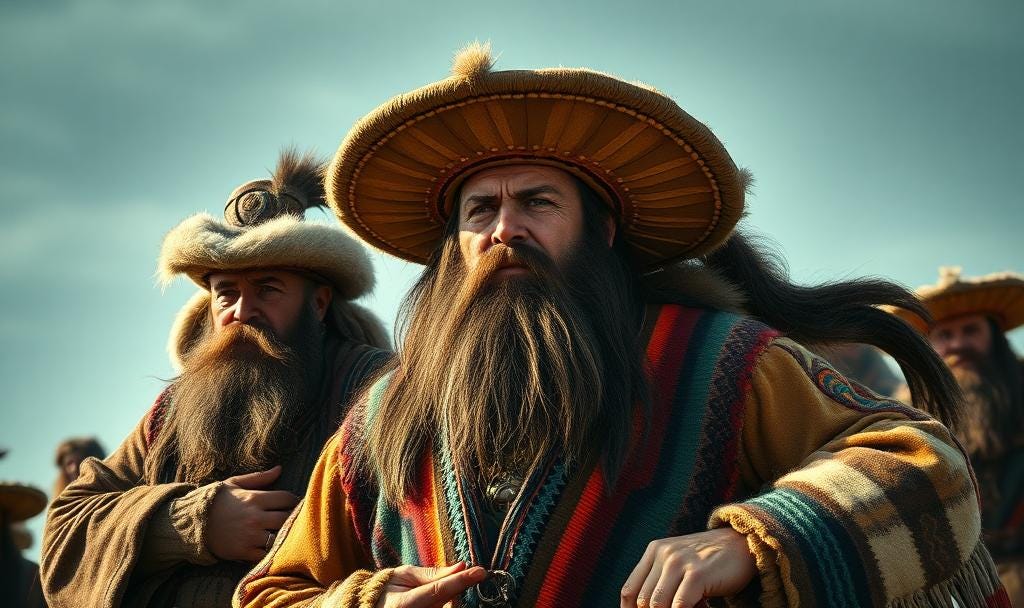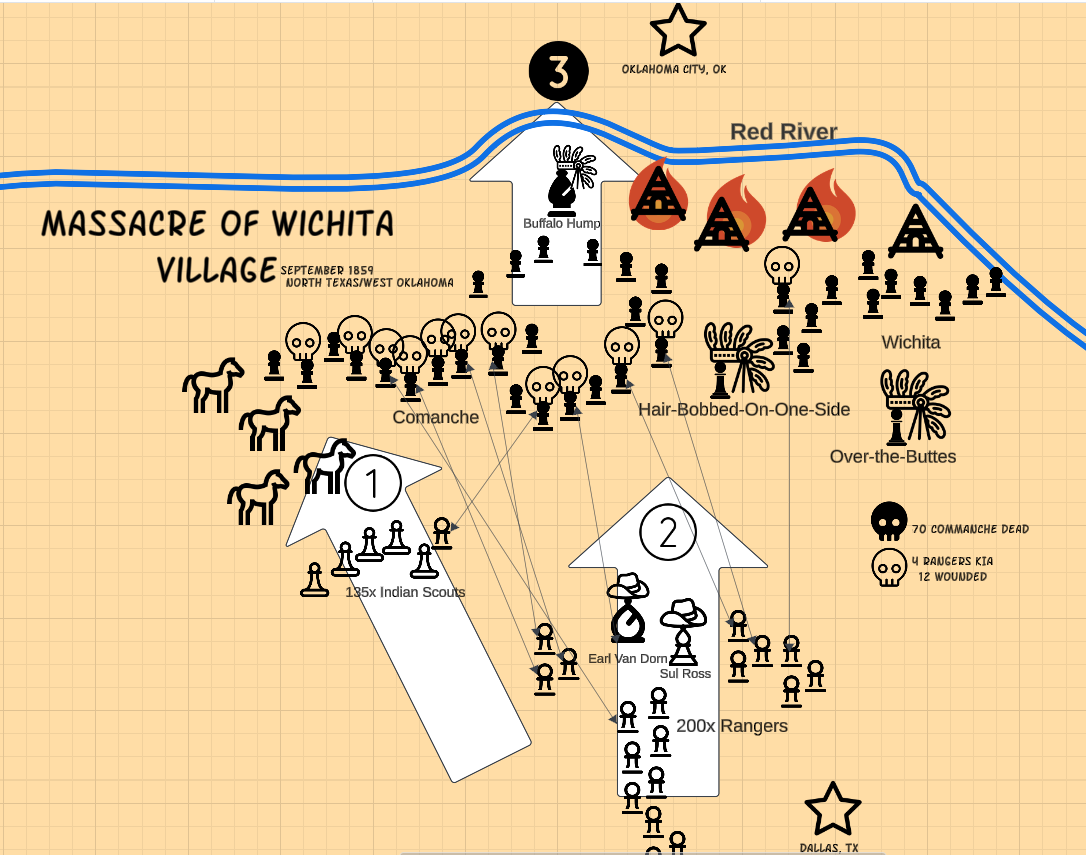Texas Rangers Golden Years
~1838-1850. notes on chapters 8-10 of Empire of the Summer Moon
Stone Man War Tactics
Comanche Cavalry vs. American Infantry
Wallace and Hoebel described the Comanche on horse as -
a wedge-shaped mass morphs with precision into a huge wheel without spokes, whose rims consists of moving lines of warriors. The ring, winding around with machinelike regularity, approached nearer and nearer each revolution. As a warrior approached the point on the circle nearest the enemy, he dropped into the loop around his horse’s neck and shot arrows from beneath the neck. If his horse was shot, he landed on his feet. ESM pg. 134
Like a circular saw to a block of wood. Sawdust flew until the Rangers learned to fight from the saddle. Only the Kiowa and Comanche fought from horseback in wheeling formations; the other mounted tribes rode horses into battle then dismounted to fight.
[1] The circular vyuha of mounted Comanche allowed warriors to fire arrows as they passed the White Men at a full gallop. As soon as one warrior finished shooting arrows the next warrior followed into position. The White Men in formation ate a steady stream of arrows fired from moving targets at a single point of attack from the outermost wheel’s rim. The wheeling motion decoupled a full speed tilt from movement, allowing the warriors to fight at a gallop from a steady slow-moving position on a battlefield.
[2] The British ‘box’ formations to counter Napolean’s lancers became standard tactics for infantry against mounted attack after Waterloo. From a box formation soldiers can fire in any direction and cannot be flanked. The box is multi-walled, only the outermost walls of men fire their weapons. The interior men act as support, ready to move to the outer wall after the exterior men are spent. The men in exterior positions fallback to an interior of the box to reload while interior men step forward to fire. Wounded men are dragged to the center from the exterior. Against the mounted, wheeling Comanche on a gun smoke and dust choked battlefields the box men were sitting ducks.
Colonel Richard Dodge observed the Comanche, “will grasp five to ten arrows in his left hand and discharge them so rapidly that the last will be on its flight before the first has touched the ground, and with such force that each would mortally wound a man at 20-30 yards.” ESM pg. 32
Until the White Men invented repeating pistols in 1840 and learned to fight on horseback, single shot or repeater rifles were hopeless without significant cover - such as overturned wagons, a canyon or protected elevated position, or forts - stationary structures that Comanche could simply avoid.
Texas

Texas lingered outside the union for many years after independence from Mexico in 1836 due to politics - having hostile Mexicans and Indians to the southwest and north gave America cold feet from taking on Texas’ burdens as a member of the union. Left alone and at war with ruthless Mexican and Comanche, the Texas government could scarcely afford luxuries like diplomacy or properly paid troopers to defend territory. They had to fight and fight on a shoestring. This harsh political climate birthed the legendary Texas Rangers.
Comanche warriors carried a disk-shaped buffalo-hide shield, a fourteen-foot plains lance, a sinew-backed bow, and a quiver of iron-tipped arrows. Their feats with the bow and arrow were legendary. The shields were surprisingly effective against bullets, at the right angle could stop any bullet from a musket and, later, rifles. The lances were deadly; Indians used them to spear three-thousand-pound buffalo from behind, between the last rip and hip bone at a full gallop.
Empire of the Summer Moon pages 132-133
Rangers
Most of the battles that The Rangers fought with the Comanche went unrecorded by history. They took place in the wildlands of Texas. Many of the young men died, leaving none to tell the tale. The Rangers were fighting men - reflection and writing about what happened was beyond their sensitivities. Many Rangers were illiterate. Many Rangers were savages who enjoyed hunting men and fighting and that was the extent of it. They suffered appalling numbers of casualties - more than half of the rangers died every year. They lived rough. They drank. They gambled and brawled. They killed and they were killed in large numbers. They drilled and practiced shooting from the saddle of a galloping horse. Many of their fights on the bleeding edge of the frontier against a fierce people defending their homeland were hard fought losses. The Rangers first submitted to the leadership of twenty-three-year-old Jack Hays.
These are a few more of the events that made it into history.
[1] Captain John Bird and thirty Rangers give chase to 27 warriors skinning buffalo near Fort Milam. After a futile pursuit, Bird and the men turn around.
[2] When the Rangers look over their shoulders, they see many more Indians have arrived and are now chasing them. Bird and his men run, taking cover in a ravine to fight off the attack. Bird and six soldiers die, but that the entire force is not destroyed is considered a victory.
[1] Outnumbered 20-to-1, John Coffee ‘Jack’ Hays leads the Rangers’ charge against a mounted force of Penateka Comanche who have crossed the Guadalupe River with a herd of stolen horses. The Rangers kill the headman, causing confusion and dismay. The astonished Comanche flee in defeat.
Jack Hays used well timed aggression to buck the odds many times.
Rangers and Indian Scouts track the Kotsoteka (Buffalo Eaters) Comanche band to a camp on the Canadian River.
[1] The Indian Scouts are sent first to draw the Comanche into a fight. The Indian Scouts kill Chief Iron Jacket with gunfire. Iron Jacket wears old Spanish Conquistador Armor into battle.
[2] The rangers arrive to rout the fleeing Comanche. A running battle ensues over 3x6 square miles.
[3] A new group of Comanche arrive, perhaps under Peta Nocona, and a engage in one-on-one duels with the Tonkawa scouts. The battle rages for half an hour, but no one dies.
[4] The Rangers break up the fight by attacking the flank of Comanche, who break and run. A running 3-mile battle ensues with no casualties before both forces break off in exhaustion.

Twilight
By the 1850s, the Rangers had fallen to murderous barbarism. The Rangers were still rough and tumble men but no longer had the discipline and fearlessness of the Jack Hays glory days of the 1840s. Hays’ idea to meet the Comanche on the battlefield as equals had fallen out of fashion. White Men realized the best way to defeat the Comanche was not to beat them at their own game of plains war - but to sneak up on their camps at night riding deep into Comanche territory, run off their horses if possible so the warriors could not even get mounted to fight, and kill every man, woman and child in their sleep. After White Men embraced murderous ideas of ‘war’ they ‘defeated’ the Comanche.
A force of Texas Rangers with Indian scouts track Buffalo Hump to an Indian village on the Canadian River where the Comanche and Wichita are hob-knobbing. The Comanche are especially relaxed, having just made peace with a separate group of White Men. The White Men attack the sleeping village in early morning.
[1] The White Men send the Indian scouts to stampede the Comanche horses.
[2] The Rangers dry-gulch the sleeping Natives, blazing into the village in early morning hour.
[3] Buffalo Hump and many warriors escape.
Meditation on Violence & Violins
‘The land’s genes get into you.’
- heard at “How Colorado Land was Stolen from Native Nations: The Costs, the Consequences, and What We Can Do Now”. Rick Williams (Oglala Lakota/Northern Cheyenne), President, People of the Sacred
Not for the first time I heard the notion - interesting to consider. the land has soul. Do some parts of the world seem recurrently brutal? Do some seem to breed opportunity and optimism? Conflict? Or pessimism? Within some dim scope, communal identity seems comprehensibly constrained to some landed structure.
Many find America’s expressions of freedom baffling or laughable - like pictures of bikers with festooned with feathered tassels riding into vast spaces between blood red canyons with golden eyed eagle’s soaring overhead - are ideas rooted in pre-USA context. Many find American expressions of freedom garish, corny or bewildering - but these ridiculous notions may come with the territory. The biker vision of freedom roaring over 100s of miles of desert highway links to whatever spirit animated the land’s ancestors who roamed vast distances on foot or hoof. People here always roamed like the buffalo. Before the Comanche mastered the horse, American people west of the 98th ran on foot unthinkable distances to the European mind - distances up to 70-80 miles a day - as Tarahumara people do today.
Orwell linked the narratives of the past present and future to power. Despite her greatest depredations, America did not wipe the native people out as a final solution. Whatever the complicated history, erasure is no longer American policy. Native tribes today are alive and growing - like hundreds of tiny flowers blooming on a mountain after a fire blasted the landscape. A shared future remains on the wing.
Gwynne, S C. Empire of the Summer Moon : [Quanah Parker and the Rise and Fall of the Comanches, the Most Powerful Indian Tribe in American History]. London, Constable, 2011.

Rupert Norval Richardson. The Comanche Barrier to South Plains Settlement. Eakin Press, 9 Feb. 2023.














